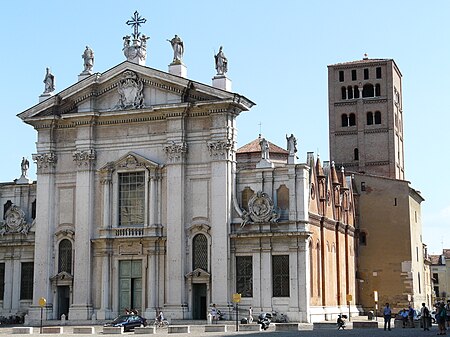The Camera degli Sposi ("bridal chamber"), sometimes known as the Camera picta ("picture chamber"), is a room frescoed with illusionistic paintings by Andrea Mantegna in the Ducal Palace, Mantua, Italy. During the fifteenth century when the Camera degli Sposi was painted, Mantua was ruled by the Gonzaga, who maintained Mantua's political autonomy from its much stronger neighbors Milan and Venice by bidding their support out as a mercenary state. By commissioning Mantegna to paint the chamber, Ludovico III Gonzaga, the Marquis of Mantua, sought to give the Gonzaga rule more cultural credibility at a time when other Northern Italian courts such as the Ferrara were commissioning their own “painted chambers”.
The Camera is located on the first floor of a northeastern tower in the private section of the Ducal Palace, with windows on the northern and eastern walls, overlooking Lago di Mezzo. This room would have been used for several different private and semi-private functions such as a bed chamber for Ludovico, a gathering area for family and close courtiers, and a reception room for particularly important guests. The semi-private functions of the room helped to create an air of exclusiveness to the Camera degli Sposi that was meant to impress viewer with the wealth and cultural prestige of the Gonzaga without an overt or gaudy display. Before Mantegna began painting, the room was renovated to be as close to a square as possible with the dimensions of roughly eight by eight meters wide and seven meters tall. Original architectural features of the room include the triple vaults on each wall, a fireplace on the north wall, doorways on the west and south walls, and windows on the north and east wall. Painted between 1465 and 1474, the Camera degli Sposi became well known shortly after its completion as a masterpiece in the use of both trompe-l'œil and di sotto in sù.The effect of Mantegna's illusionistic painting that is suggestive of a classical pavilion is complete with subtle shifts in vantage points that make each fictive element of the illusion seem real to the viewer. On the northern and western walls, framed by fictive marble title on the bottom and a painted curtain rod that runs the full length of each of the walls at the top, are meeting scenes of the Gonzaga and their court in front of sweeping idealized landscapes that appear to be revealed to the viewer by curtains that are drawn or loose in the breeze. The southern and eastern walls appear to be veiled by golden brocaded curtains that mimic the ones that would have been used for the canopy of Ludovico's beds, the hooks for which are still in the ceiling above the southeastern corner of the room. Above these scenes fictive ribbing divides the ceiling onto sections containing faux stucco mandolins of the first eight Caesars of Rome carried by winged putti, and in the center, an oculus that opens on to blue sky with putti that appear as if they are far above the viewer, playing on the balustrade, along with several women looking upon the gathering below them, a few men, and a large potted plant extending into the oculus with a crossbar support.











